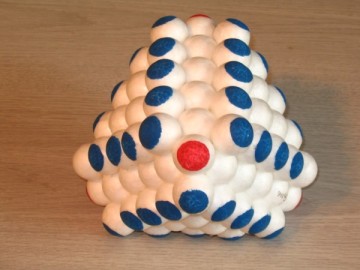
Diamond
.jpg)


.jpg)
Organic Carbon Atom
Rhodium Nucleus
Tin
Neutron Hexacores
Atomic and Nuclear Modeling
BUILDING MODELS
Model Cataloging And Licensing
Individuals who would like to be a part of this historic project by contributing to the development and cataloging of models for all the elements, including their allotropes and isotopes are invited to do so under a personal use license of the LNH Atomic model as part of your purchase price of the ebook. Any models to be submitted for official evaluation, cataloging and author recognition must be posted to our email or postal address with a detailed explanation of reasoning, adequate photographs (maximum 200 KB please) or illustrations and a preliminary evaluation fee of $50 US (refer to our Services page for contact information details).
Unofficial models can be posted at the discretion of the creator, provided the source is referenced in the following manner "Based on the Lattice Nested Hydreno Atomic Model by Mark Porringa" with the website address www.lnhatom.com included. The unconcerned hobbyist may prefer this route for financial reasons, but chances of official recognition for your efforts are greatly diminished as potential infringement of your own, subordinate copyright would be greatly enhanced.
Any royalties arising from commercial application of new atomic and nuclear models are the joint property of Mark Porringa of ZEROPOINT TECHTONIX Inc. and the recognized model creator, on a 50/50 basis in recognition of the fact that the author has invested almost ten years developing this new concept without significant remuneration to date. By comparison anyone with a bit of a knack for geometry could probably produce viable models within a few hours of applying these modeling principles. Please do not succumb to the rather pervasive practice of stealing copyrighted materials and intellectual property.
Elements that have already been analyzed or modeled in the process of spot checking the Hydreno atomic theory include several of the stable isotopes and nuclear based allotropes of H, He, Li, Be, B, C, N, O, F*, Ne, Na, Mg, Al, Si, S*, Cl*, Ar, K, Ca, Fe*, Co*, Ni*, Cu, Ge*, As*, Br, Kr, Zr*, Mo, Tc, Ru, Rh, Pd*, Ag*, Cd*, In, Sn, I, Xe, Pt*, Au*, Pb*, Th, U*, Pu*. Unstable isotopes within the range of stable isotopes are also reasonably well identified.
However, this is not to suggest that all of these models are strictly correct or that all the isotopes and allotropes have been adequately identified. Independent analysis and verification by other parties (especially for those elements identified with an asterisk*) is certainly welcomed. In the event of any significant revisions, officially acknowledgement will be provided. Those radioisotopes outside the stable range are presumed to be less determinate and have not yet been investigated in any detail.
To greatly facilitate the modeling process and standardize presentation methods, proposals are invited from software companies for licensed computer programs that would permit development of three dimensional models providing three axis rotation and shadowing capabilities. Ideally, such software should also include the capability of hydreno orbital presentation superimposed on the geometry of the nucleus to capture the strong connection between the nuclear and atomic structure. Nuclear crystallography software will eventually be used for presentation of a complete set of atomic models to be posted on this and other websites.
All other forms of duplication or commercial application of the Hydreno Atomic Model are strictly forbidden without the expressed written permission of the copyright owner. Licensing inquiries can be directed to our Licensing section.
The Modeling Process
(Many Critical details are missing to encourage purchase of ebook, which is required for official participation and any form of model publication)
Atomic model building begins by first collecting all the relevant empirical data and other information on the chosen element and its isotopes. This includes things like the elemental crystal structure, valences, bond angles, neutron and proton counts and so on. Based on this information, several prospective neutron core geometries are selected using correlating information from the Table Of Nuclear Geometry (provided in the ebook) that appears to have good prospects of accommodating the observed characteristics of the element, including the range of neutron counts in the stable isotopes.
Once the neutron core is constructed, the Hydreno and Peripheral neutron bond sites become readily apparent. Hydrenos are always located in a nested position on the surface of the neutron core forming the apex of a tetrahedral or pyramidal base in general accord with the orbital orientations observed in conventional chemistry. The high energy valence hydreno sites constituting the chemical bonding positions always occupy the positions of greatest spatial freedom and exposure to the active vacuum and are preferentially located in the tetrahedral nesting sites so as to avoid excessive crowding and mutual coulomb repulsion.
Hydrenos located along the edges provide the intermediate orbital levels and the smaller facet positions provide the lowest energy orbitals due to the diminished exposure to the ZPF. Positions in the center of larger facets, which are surrounded by hydrenos, provide locations for peripheral neutrons due to the high degree of shadowing that can no longer support a hydreno orbital state. Elements exhibiting many isotopes must therefore have large or numerous facets to accommodate many peripheral neutrons.
Alternative geometries of the neutron lattice core give rise to Isobars or different nuclear allotropes of the elements such as graphite and diamond, which in effect constitute nuclear transition isomers. The various allotropes of an element are constructed by rearranging the nucleons so as to place the high-energy bonding hydrenos at other logical bond sites providing alternate bond angles and valence options. Chemistry based allotropes are presumably more prevalent and are caused by altered valence states that do not alter the nuclear geometry.
The whole process involves a fair amount of trial and error iteration, intuition and deductive reasoning that will no doubt improve with experience. Until specialized software becomes available, existing graphics or CAD software can probably be employed. Simple, low tech, physical models using 1" styrofoam spheres or their equivalent, assembled with low temperature hot melt glue also works fine. Physical models are actually more instructive in correlating and visualizing the complexities of the process.
© 2006, 2007
.jpg)
Cuboctacores
(Updated Mar 05/07)